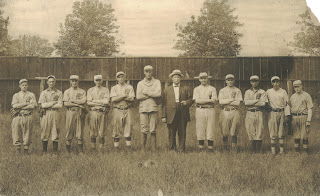HISTORIC SPORTS VENUE OF TORONTO, OHIO
Hallowed
is the ground where the glinted steel spikes of summer and autumn once trod in
the north end of Toronto.
This small piece
of earth, Kaul Field, where the bowling alley currently sits parallel to the
1100 block of Fifth Street, served as home field for some of Toronto’s most
revered sports heroes, including Pick Nalley, Gabby Kunzler, Clarke and Gordie
Hinkle and Hook Comer.
Soon
after the turn of the Twentieth Century baseball became vogue in the Gem City,
with a semi-pro team, the Toronto Athletic Club, dominating most local
nines. At Kaul Field, the TAC
hosted other semi-pros from the area and sometimes others of higher caliber.
“The
Pittsburgh Pirates came barnstorming into town along with Honus Wagner,” John
Petras said. “I can’t remember who
won, but yes they did play in Toronto.”
Petras,
now resides in Royal Oak, Michigan, is the son of John Petras Sr., who was a
member of the TAC before World War I and played alongside Pick Nalley, Wenzel
Straka and other founding fathers of baseball in the Gem City.
At the end of the 1918 Pittsburgh Pirates' season, Bill Mekechnie dropped out of baseball and moved his family to little Toronto where he took up a position of sales for Kaul Clay. He also set up a grocery in the Daniels Building. The following year, Mekechnie became player-coach for the Toronto Athletic Club and convinced no retired Pittsburgh Pirates legend Honus Wagner to play games for Toronto on weekends. Both would eventually be inducted into the Baseball Hall of Fame in Cooperstown.
 |
| Honus Wagner |
A
wooden fence enclosed Kaul Field then, but sometime around the 1920s the only
wooden structure remaining was the grandstand framing the home plate area at
the site approximately where the cul-de-sac is today on Fifth Street.
It
was this period that Toronto resident Tom McKelvey remembers well. “Kaul Field was used for baseball in
the summer and football in the fall,” McKelvey said. “We had church leagues five nights a week, Monday through
Friday. Every church had a team. The best team was always St. Francis,
who we called back then the Mickeys”
McKelvey
also has fond memories of the semi-pro football club, the Toronto Tigers, when
professional football was at its infancy and germinating in northeastern Ohio.
“The
Toronto Tigers played their games at home in the fall months in front of good
crowds,” McKelvey said. “The train
pulled in across the field and the opposing players and fans stepped off; then
walked to the field.”
According
to McKelvey, the Toronto Tigers and their opponents played with fierce
competition, locals occasionally being replaced by ringers--college athletes
playing for dough under aliases.
“I
heard two Ohio State players came in playing for 100 or 200 dollars. Fats Henry came in from Washington and
Jefferson. Henry would later play
for the Canton Bulldogs and become inducted in the Hall of Fame”
Some
of the Toronto standouts included the Ferris brothers and Hook Comer. Comer had a short stint at fullback
with the Canton Bulldogs alongside Henry and the great Jim Thorpe.
Toronto
High School also staged its football games at Kaul Field prior to 1930. McKelvey’s father, Tom Sr., took young
Tom to watch his first game, a match-up between Toronto and Warwood.
“There
were no lights back then,” McKelvey said.
“The games were held in the afternoon. There were ropes stretched along the sidelines to keep us
from coming onto the field.”
Kaul
Field was used for other endeavors beside sports during that era. McKelvey said a traditional ox roast
was held at the grounds around Thanksgiving Day.
“I
remember the kids from the north end ice skated in the winter there,” Vince Exterovich,
a 1942 THS graduated said. “There
was a pond, actually a marshy area that froze over during the winter. Mostly north end kids skated there.”
Exterovich
resided at Sixth Street back then, considering himself a south ender. Today, the line separating the two ends
of the Gem City runs east to west along Main Street, making the southern end
larger in area than the older north. All of Sixth Street today is located what is considered the
north end.
“The
south end wasn’t developed in those days,” McKelvey said. “It was mostly farms and Sloane’s.”
During
the Forties and the Fifties, with the emergence of Little League at newly built
Memorial Park and the development of the south end with its new schools, Kaul
Field was reduced to a sandlot until it ceased to exist at all with the
construction of Toronto Lanes around 1960.





1 comment:
I am Tom McKelvey's grandson. He was a great man and one of the kindest, loving people I have ever known. I had been told that he spoke with a writer years ago, and that the conversations had been recorded. If you could please let me know if you have any material that he shared (stories, recording, etc.), I would be very appreciative. Thanks for you time, and I look forward to speaking with you. You can email me at ericmckelvey@gmail.com
Post a Comment